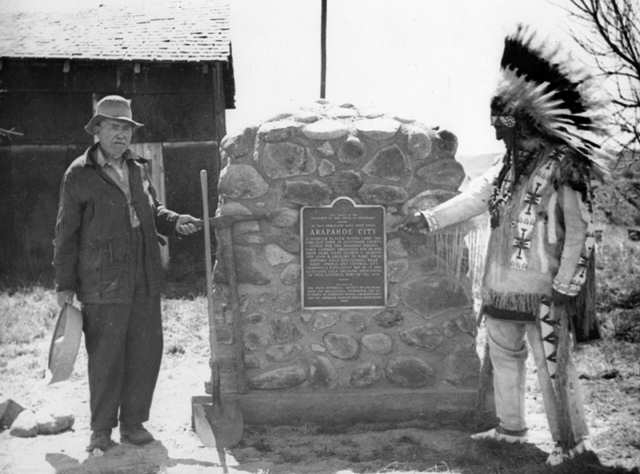

Arapahoe City was one of the earliest Colorado towns. The Arapahoe Town Company was organized and elected Marshall Cook as president, George B. Allen secretary and Thomas L. Golden, treasurer. The Arapahoe Town Company was very generous, allowing every settler a lot free of charge, with members of the town company required to build a cabin in a specified period of time.

Survey of Arapahoe City dweller Samuel S. Curtis’ claim adjoining Arapahoe City when he sold it to D.P. Foote in 1859
According to Jefferson County records Arapahoe City appears
to have been laid out as a grid and surveyed into blocks and lots. One direction
of the town’s streets were lettered, such as A Street, B Street, etc.
at least up to G Street, while streets in the other direction were numbered,
at least up to 2nd Street. The townsite was laid out by George B. Allen, whose
1868 stone house built just east of the town still stands on West 44th Avenue.
Arapahoe City initially was shelter from the harsh winter of 1858-59 and a base
camp for miners to go hunt and prospect in the mountains. Its buildings were
made largely of hewn logs chopped from the pineries of the nearby mountains,
and pine log fires warmed those talking over prospects over the long winter.
Food was obtained often by hunting wild game on the Table Mountains or the areas
nearby, including buffalo, deer, elk, and mountain sheep. Miners continued to
mine gold at the bar, but the fine flour gold there proved elusive. Recreation
was not; George A. Jackson wrote in his diary “spent the night playing
poker for buckskins; won 20 green hides and 7 dressed ones.”

Arapahoe dwellers hunted mountain sheep for food like these
on North Table Mountain
Courtesy Gardner Family Collection
Among arriving miners were Jackson and John H. Gregory. At Arapahoe City Jackson
built himself a cabin and intended to remain there for the balance of the winter.
He befriended Tom Golden and continued to keep an eye out for gold from here
and camping in the future Golden valley. On Clear Creek Jackson impatiently
tried to find coarser mountain gold but was stymied by the depth of snow. However,
his perseverance finally paid off when he struck gold at today’s Idaho
Springs on January 7, 1859. He told only Golden about his find, writing in his
diary “as his mouth is tight as a No. 4 beaver trap, I am not uneasy.”
Gregory also ventured into the mountains, making it to the future site of Black
Hawk. He found indications of gold but a snowstorm forced him back to Arapahoe
City. Gregory told his secret to a few people, among whom was David K. Wall,
who was starting out in farming in the Golden valley, who agreed to provide
Gregory food for further prospecting efforts. With some of Wall’s men
Gregory made his own rich followup discovery on May 6, 1859. Jackson’s
and Gregory’s finds sent the Colorado Gold Rush into full boom, leading
to the settlement of this state. Spring of 1859 had the first building boom
in Jeffco history at Arapahoe City, where around 20 buildings were built. Comprising
most town construction to that time, they were built on the bluff overlooking
the river mining district. The Casto-Kendall Company started in transportation.
The first to take a wagon to the Gregory Diggings in May 1859, they had hauled
the goods of the Gregory party themselves including only the front wheels of
the wagons as no roads existed at the time. They went straight up the faces
of the mountains, with the Gregory members walking alongside.

Arapahoe Express advertisement from Casto, Kendall &
Co.
From the 1st issue of the Rocky Mountain News, April 23, 1859
Earliest known published ad by a Jefferson County business
By the end of 1859 Arapahoe City had around 200 inhabitants. This was enough
to warrant its gaining the honor of having the first post office in Jefferson
County, of which Asa Smith was postmaster, in early 1860. However, just upstream
the new Golden City had materialized, named after Tom Golden and a competitor
to Arapahoe. They competed to become the seat of Jefferson County, and on January
2, 1860 Golden City won by 401 votes to Arapahoe City’s 288. In Jeffco’s
first census in 1860 Arapahoe City had 80 citizens living in 21 residences.
By this time Arapahoe was fading away, with Colorado historian Jerome Smiley
saying “The rise and prosperity of Golden caused the decline and fall
of Arapahoe. Many moved their log buildings to Golden.” Ironically the
namesake of one of Arapahoe’s own citizens helped cause Arapahoe to vanish.
Afterward Arapahoe Bar continued to be mined periodically for gold, including
hydraulic and dredge mining, while the area evolved into the rural community
of Fairmount. On April 28, 1946, the Colorado Historical Society placed a bronze
marker on the site of Arapahoe City, commemorating the past that helped give
this area its future.

Dedication of historic marker of the site of Arapahoe City,
April 28, 1946
At left is Charles L. Palmer, one of first white children born in Arapahoe's
vicinity, and Sioux Chief Big Snake
Courtesy Colorado Historical Society
Extended History of Arapahoe City, from Historically Jeffco magazine